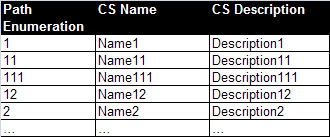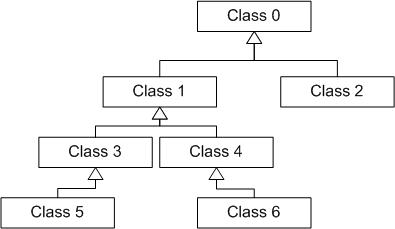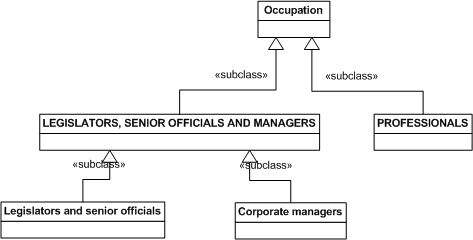Submissions:Pattern for re-engineering a classification scheme, which follows the path enumeration data model, into an ontology schema
From Odp
m (Text replace - '{{Reviews about me}}' to '{{Reviews about me}}{{Modeling issues about me}}') |
|||
| Line 80: | Line 80: | ||
{{Scenarios about me}} | {{Scenarios about me}} | ||
| - | {{Reviews about me}} | + | {{Reviews about me}}{{Modeling issues about me}} |
Revision as of 13:25, 1 March 2010

| If you are a member of quality committee please visit the
If you are author of this proposal or you want to contribute to this pattern's review, you can: ask for a review post your open review specify if this revision takes in account any of the review(s)add a new scenario for Pattern for re-engineering a classification scheme, which follows the path enumeration data model, into an ontology schema In general, it could be useful to visit the evaluation section to have informations about the evaluation process of this proposal Current revision ID: 8253 |
General information
| Name | Pattern for re-engineering a classification scheme, which follows the path enumeration data model, into an ontology schema |
|---|---|
| Problem | Re-engineering a classification scheme which follows the path enumeration data model to design an ontology schema |
Non-Ontological Resource
| Description | A non-ontological resource holds a classification scheme which follows the path enumeration model.
A classification scheme is a rooted tree of concepts, in which each concept groups entities by some particular degree of similarity. The semantics of the hierarchical relation between parents and children concepts may vary depending of the context. The path enumeration data model, for classification schemes, takes advantage of that there is one and only one path from the root to every item in the classification. The path enumeration model stores that path as string by concatenating either the edges or the keys of the classification scheme items in the path. |
|---|---|
| Graphical Representation |
Diagram |
Ontology
| Description | The generated ontology will be based on the taxonomy architectural pattern (AP-TX-01). Each category in the classification scheme is mapped to a class, and the semantics of the relationship between children and parent categories are disambiguated by using an external resource. In the case of that the external resource does not provide any relation between two items, the pattern takes advantage of the use of logical patterns for asserting the relation partOf or subClassOf, as appropriate. |
|---|---|
| Graphical Representation |
Diagram |
Process
| Description | 1. Identify the classification scheme items whose their path enumeration values have the shortest length, i.e. classification scheme items without parents.
2. For each one of the above identified classification scheme items cei: 2.1. Create the corresponding ontology class, Ci class. 2.2. Identify the classification scheme items, cej , which are children of cei, by using the path enumeration values. 2.3. For each one of the above identified classification scheme items cej : 2.3.1. Create the corresponding ontology class, Cj class. 2.3.2. Using the external resource identify the semantics of the relation between Cj and Ci and set up the relation identified. 2.3.3. Repeat from step 2.2 for cej as a new cei. 3. If there are more than one classification scheme items without parent cei 3.1. Create an ad-hoc class as the root class of the ontology. 3.2. Using the external resource identify the semantics of the relation between Ci class and the root class, and set up the relation identified |
|---|---|
| Graphical Representation |
Diagram |
Scenario example
| Description | Suppose that someone wants to build an ontology based on the International Standard Classification of Occupations (for European Union purposes) ISCO-88 (COM). |
|---|
Example of a Non-Ontological Resource
| Description | The International Standard Classification of Occupations (for European Union purposes), 1988 version: ISCO-88 (COM) published by Eurostat is modeled with the path enumeration data model. |
|---|---|
| Graphical Representation |
Diagram |
| Web Reference | http://ec.europa.eu/eurostat/ramon/nomenclatures/index.cfm?%20TargetUrl=LST_NOM&StrLanguageCode=EN&IntFamilyCode=260276&TxtSearch= |
Ontology example
| Description | The generated ontology will be based on the taxonomy architectural pattern (AP-TX-01). Each category in the classification scheme is mapped to a class, and the semantics of the relationship between children and parent categories are disambiguated by using an external resource. In the case of that the external resource does not provide any relation between two items, the pattern takes advantage of the use of logical patterns for asserting the relation partOf or subClassOf, as appropriate. |
|---|---|
| Graphical Representation |
Diagram |
| Web Reference | http://droz.dia.fi.upm.es/hrmontology/ |
Process example
| Description | 1. Create the LEGISLATORS, SENIOR OFFICIALS AND MANAGERS class.
1.1. Create the Legislators and senior officials class. 1.2. Using the external resource identify the semantics of the relation between Legislators and senior officials and LEGISLATORS, SENIOR OFFICIALS AND MANAGERS and set up the relation identified. 1.3. Create the Corporate managers class. 1.4. Using the external resource identify the semantics of the relation between Corporate managers and LEGISLATORS, SENIOR OFFICIALS AND MANAGERS and set up the relation identified. 2. Create the PROFESSIONALS class. 3. Create the Occupation class. 4. Using the external resource identify the semantics of the relation between LEGISLATORS, SENIOR OFFICIALS AND MANAGERS and Occupation and set up the relation identified. 5. Using the external resource identify the semantics of the relation between PROFESSIONALS and Occupation and set up the relation identified. |
|---|---|
| Graphical Representation |
Diagram |
About
| SubmittedBy | BorisVillazón-Terrazas |
|---|---|
| Author | BorisVillazón-Terrazas |
| Also known as | |
| Known uses | |
| Related to | Use the Architectural Pattern: TX-AP-01 |
| Other References |
Scenarios
No scenario is added to this Content OP.
Reviews
There is no review about this proposal. This revision (revision ID 8253) takes in account the reviews: none
Other info at evaluation tab
Modeling issues
There is no Modeling issue related to this proposal.







